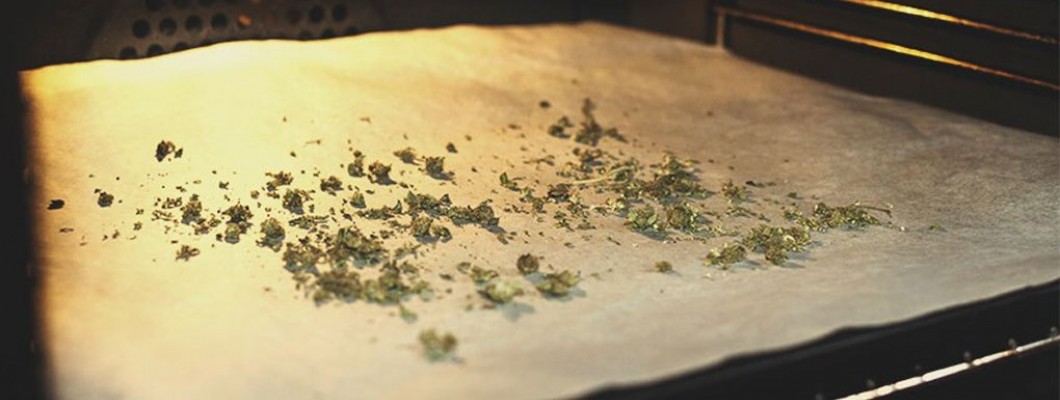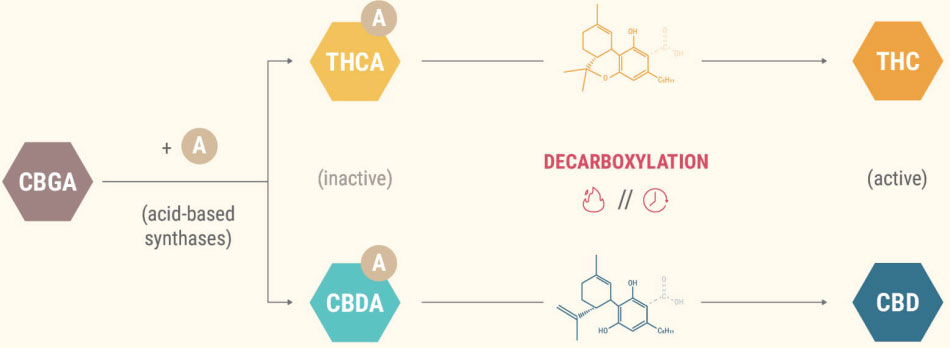
Decarboxylation of industrial hemp may sound complicated, but in reality, many growers have probably operated it . In simple terms, decarboxylation means heating industrial hemp, which is the only way to ensure maximum utilisation of industrial hemp.
The phytochemicals contained in raw industrial hemp are nothing like the phytochemicals contained in edible industrial hemp. Nor does a whole bag of raw industrial hemp get you high. This is because raw industrial hemp is not biologically active; more precisely, it has only very low levels of biological activity. What the fresh, sticky buds are rich in are precursor chemicals known as cannabinoid acids. These precursor chemicals require a heating reaction - a process known as decarboxylation - to convert the non-biologically active cannabinoid acids into the cannabinoids we know and love.
What is decarboxylation?
Decarboxylation is a type of reaction in which the carboxylic acid molecule of an organic compound loses its carboxyl group to release carbon dioxide. This simple chemical process ensures the efficient use of the beneficial cannabinoids in industrial hemp.
What is cannabinoid acid?
A closer look at industrial hemp buds reveals a small layer of crystal structures - trichomes - which release cannabinoid acid-rich resins such as THCA and CBDA. as scientific research on industrial hemp continues to progress, researchers have discovered that these cannabinoid acids also have their own unique effects (THCA has no psychoactive effects).
At what temperature does decarboxylation take place?
Industrial hemp is decarboxylated and the THCA, CBDA and other cannabinoid acids contained in it are converted into the corresponding cannabinoids such as THC and CBD, thus exerting the various beneficial effects we know industrial hemp to have on human health.
The decarboxylation temperatures for CBDA and THCA are usually the same: both are converted to CBD and THC respectively after 30-45 minutes of heating at 110°C. This temperature does not affect the aromatic terpenes and other useful phytochemicals.

Benefits of Decarboxylation
The benefits of decarboxylation are numerous, two of the main ones being the activation of cannabinoids and protection against pathogens.
1. Activation of Cannabinoids
Decarboxylation activates the components of industrial hemp that have a psychoactive effect (i.e. THC, but the THC content of decarboxylated industrial hemp should also not exceed 0.3%) as well as the overall components (CBD, etc.).
2.Prevent Germs
Decarboxylation also has a protective effect on industrial hemp. Although industrial hemp flowers are not usually infected with pathogens at the time of harvest, they can still emerge during post-harvest storage. Decarboxylation helps to remove water from industrial hemp flowers, reducing the chance of microbial infection.
Necessity of Decarboxylated CBD Strains
Although cannabinoid acids such as CBDA also have some benefits, decarboxylated cannabinoids such as CBD are more valuable and better known to the general public, and the research, technology, etc. is more mature. The use of decarboxylated CBD buds in foods, tinctures or oils, for example, ensures the best results.
Decarboxylation Temperature
The decarboxylation temperatures for most of the major cannabinoids are essentially the same. As mentioned above, decarboxylation of cannabinoids is completed at 110°C for 30-45 minutes.
1. Boiling points of cannabinoids, terpenoids and flavonoids
THC----------------157 ℃
CBD----------------160-180 ℃
2. Terpene
The aroma and distinctive flavour of each industrial hemp comes from the terpenes it contains. In addition, terpenes act synergistically with the cannabinoids to enhance each other's effects.
Caryophyllene--------------------------119 ℃
Myrcene---------------------------------166-168℃
Cineole-------------------------------------176℃
Limonene----------------------------------177℃
Linalool--------------------------------------198℃
Terpineol------------------------------------218℃
3. Flavonoid
In addition to hundreds of cannabinoids and terpenoids, industrial hemp contains flavonoids.
Flavonoids have antioxidant properties and while some are found everywhere in the plant world, others are only found in industrial hemp.
Apigenin---------------------178 ℃
Cannflavin-------------------182 ℃
Quercetin--------------------250 ℃
Industrial Hemp Decarboxylation Methods
1. Oven method
The most common method of decarboxylating industrial hemp, especially when making edible industrial hemp, is to "bake" it in an oven.The steps are as follows:
1: Grind up the industrial hemp.
2: Line a baking tray with a sheet of baking paper.
3: Pour the ground industrial hemp onto the baking paper and spread it out evenly.
4: Preheat the oven to 115°C. Place the tray in the oven for about 45 minutes, turning it over halfway through.
Keep a close eye on the oven temperature during the roasting process. Higher temperatures will shorten the roasting time, but in reality high temperatures are likely to have the effect of degrading only the cannabinoids and terpenes, leading to a failure of decarboxylation. Prolonged roasting at lower temperatures is usually the safest and most effective method of decarboxylating industrial hemp.
2. Microwave method
If you feel that the 45 minutes in the oven method is too long, you can use the microwave method. This method can significantly reduce the time taken to decarboxylate industrial hemp. The method is as follows:
1: As with the oven method, grind the industrial hemp into medium grains and place in a microwaveable bowl or dish.
2: Microwave oven set to high for about 90 seconds.
3: Remove the industrial hemp and smell it, there is a pungent smell but it is not burnt then it is successful. If it hasn't reached that level, turn it over and put it back in the microwave for 60 to 90 seconds.
In contrast to the oven method, there is no control over the exact temperature when heating in a microwave oven. In addition, because every microwave oven is different in temperament, industrial hemp can be overcooked in minutes. If you are worried that the microwave method will scorch industrial hemp, start with a lower temperature setting and extend the microwave time. Keep an eye on the industrial hemp at all times and if the smell comes out, turn off the heat and take it out of the oven.
Whether you choose the oven method or the microwave method of decarboxylation, the key point is that the temperature should be low and not rushed. Using high temperatures to heat industrial hemp quickly can burn cannabinoids and terpenes, which can affect the quality and aroma of industrial hemp. Stick to lower temperatures and take your time and you will end up with fully decarboxylated industrial hemp.
3. Vacuum heating method.
This method is the second recommended method for decarboxylation of industrial hemp (the first recommended method is the oven method). The steps for the removal of the carboxyl group from industrial hemp by the vacuum method are as follows:
1: Grind industrial hemp buds into medium grains, place in a vacuum bag and vacuum seal.
2: If you have a vacuum precision cooking pot, put the bag in the pot, set the temperature to 95°C and cook for about 1 hour.
If you do not have a vacuum cooking pot, you can also use a stew pot, add water to the pot and bring to the boil on high heat.
3: Once the water in the stew pot is boiling, lower the temperature - use a thermometer to measure and keep the water temperature between 95 and 100°C.
4: Place the vacuum sealed bag in the water and cook for about 1 hour.
Patience is also key when using the vacuum heating method. This method takes significantly longer than other methods.
4.Natural Method
In addition, the various cannabinoid acids contained in industrial hemp are also naturally decarboxylated over time if left in a natural environment for a long period of time without any treatment. However, this process is very long and a certain amount of heat is a necessary condition.
Whichever method you use, decarboxylation is an important process for obtaining beneficial cannabinoids.

Leave a Comment